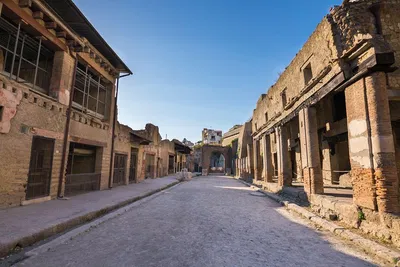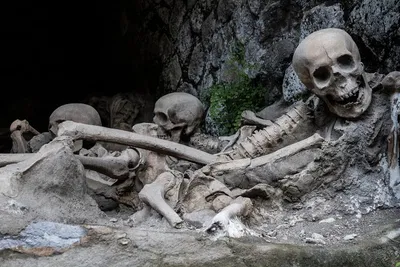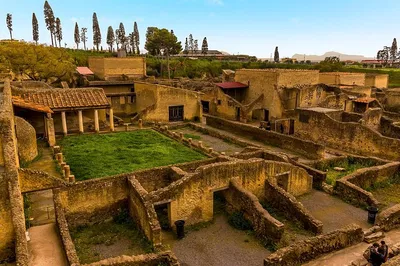Pompeii & Herculaneum: Skip-the-Line Small Group Tour
330
Overview
The Pompeii and Herculaneum small group tour offers a fascinating journey into the past, exploring two of the most well-preserved Roman archaeological sites in the world. These ancient cities, tragically buried by the eruption of Mount Vesuvius in AD 79, offer a unique window into Roman life. With this tour, visitors can skip the long lines and delve deep into history with an expert archaeologist guide.
During the tour, one can walk the ancient streets of Pompeii, see the Basilica of Pompeii, and explore the city's main square and the Main Street of Pompeii. You'll see the homes of wealthy citizens, such as the House of Menander and House of the Faun, and public spaces like the Stabian Baths and the Lupanar, Pompeii's ancient brothel. You'll also visit the Granary of Pompeii, Teatro Piccolo (Odeon), and Large Theater of Pompeii.
After Pompeii, the adventure continues to Herculaneum, a smaller but equally captivating site. Here, you'll visit the Herculaneum Ticket Office and explore well-preserved houses like the House of the Deer, House of Marcus Nonius Balbus, Wooden Partition House, House of the Skeleton, Central Thermae of Herculaneum, House of the Black Hall, Samnite House, and House with Stone Balcony and Domus in Herculaneum. This tour includes skip-the-line tickets for both Pompeii and Herculaneum, guidance from an archaeologist throughout the tour, and one-way Circumvesuviana train tickets from Pompeii to Herculaneum. Please note that meals, personal expenses, and transportation to Pompeii and from Herculaneum back to your accommodation are not included.




Highlights
Skip the Long Lines: Get right into Pompeii and Herculaneum with skip-the-line tickets.
Expert Archaeologist Guide: Learn about the history from a knowledgeable guide.
Visit Two Ancient Cities: Explore both Pompeii and Herculaneum in one tour.
Small Group Experience: Enjoy a more personal tour.
Sentiment Analysis
Overall, people enjoyed the tour. They liked skipping the lines, learning from the guide, and seeing both Pompeii and Herculaneum. Some felt a little rushed and wanted more free time.

Customers loved skipping the long lines, making the most of their time.
The archaeologist guide was very knowledgeable, sharing cool stories and facts.
Many said seeing both Pompeii and Herculaneum in one day was a great experience.
The small group size allowed for a more personal and engaging tour.
Some visitors felt the tour was a bit rushed to see everything.
A few people wished they had more free time to explore on their own.
The Journey
Porta Marina Superiore
Begin your Pompeii adventure at the Porta Marina Superiore, the main entrance to this ancient city. Imagine the bustling activity as you step through these gates, following in the footsteps of Roman citizens who once traversed this path. Meet your guide from Askos Tours, easily identifiable by the company sign, ready to unveil the secrets of Pompeii.
Basilica of Pompeii
Explore the Basilica, the grand public building in Pompeii used as a tribunal and meeting place. Envision the bustling legal and commercial activity that once filled this space, where merchants gathered under its open portico, conducting business and shaping the economic life of the city.
Pompeii's Main Square
Stand in awe at Pompeii's main square, the heart of civic and religious life. Marvel at the architectural grandeur surrounding you, including temples, government buildings, and bustling marketplaces, all meticulously preserved by the volcanic ash. Picture the vibrant energy of daily life as citizens gathered to discuss politics, conduct business, and celebrate religious festivals.
Main Street of Pompeii
Wander along the main street of Pompeii, tracing the footsteps of ancient Romans who once walked this path. Observe the remnants of shops, homes, and public buildings that line the street, offering a captivating glimpse into the daily life of the city's inhabitants. Imagine the bustling crowds, the sounds of commerce, and the vibrant atmosphere that once filled this thoroughfare.
House of Menander
Step inside the House of Menander, one of Pompeii's most opulent residences. Admire the exquisite frescoes, intricate mosaics, and luxurious furnishings that adorned this aristocratic home. Discover the remarkable architecture, decoration and contents, showcasing the wealth and sophistication of its inhabitants. The house is named after the fresco depicting the ancient Greek playwright Menander.
Granary of Pompeii
Enter the Granary, where you'll discover a fascinating collection of artifacts recovered from Pompeii. See marble tables and baths for fountains, used to adorn the entrances of houses. Most poignantly, witness casts of the eruption's victims, offering a sobering reminder of the tragic events that unfolded here, including the casts of a dog and a tree, capturing the final moments of life in Pompeii.
Stabian Baths
Explore the Stabian Baths, Pompeii's oldest and most extensive thermal complex. Wander through the separate sections for men and women, each featuring intricate mosaics, changing rooms, and various bathing pools. Imagine the social and recreational activities that took place here, as citizens gathered to relax, socialize, and maintain their well-being.
Lupanar (Pompeii Brothel)
Visit the Lupanar, Pompeii's most famous brothel, offering a unique glimpse into the city's vibrant and often-overlooked social life. Observe the frescoes depicting erotic scenes, providing insight into the customs and attitudes of Roman society.
House of the Faun
Marvel at the House of the Faun, one of Pompeii's largest and most magnificent private residences. Admire the intricate mosaics, elaborate frescoes, and stunning architecture that showcase the wealth and refined taste of its inhabitants. The house is renowned for its impressive collection of artwork, including the famous Alexander Mosaic, depicting the Battle of Issus.
Teatro Piccolo (Odeon)
Discover the Teatro Piccolo, also known as the Odeon, a smaller, roofed theater in Pompeii used for musical performances and smaller productions. Imagine the enchanting melodies and captivating dramas that once filled this intimate space, entertaining the city's elite.
Large Theater of Pompeii
Experience the grandeur of the Large Theater of Pompeii, the city's primary venue for dramatic performances and public gatherings. Envision the lively atmosphere as thousands of spectators filled the stands, captivated by the theatrical productions unfolding on stage.
Herculaneum Ticket Office
Begin your exploration of Herculaneum at the Ticket Office, located at Parco Archeologico di Ercolano, Corso Resina, 80056 Ercolano Italy. Reach this point by car via Pignalver (parking available) or by train to Corso Resina 1 (Circumvesuviana station, 10-minute walk). After a 30-minute train trip and 10-minute walk, embark on a journey to uncover this remarkably preserved ancient Roman town.
House of the Deer
Admire the elegance of the House of the Deer in Herculaneum, named for the marble statues of stags found in its peristyle garden. Explore the well-preserved rooms and imagine the life of the wealthy family who once resided here. The house exemplifies the luxurious lifestyle of the Roman elite during the peak of the Roman Empire.
House of the Deer
Admire the elegance of the House of the Deer in Herculaneum, named for the marble statues of stags found in its peristyle garden. Explore the well-preserved rooms and imagine the life of the wealthy family who once resided here. The house exemplifies the luxurious lifestyle of the Roman elite during the peak of the Roman Empire.
House of the Deer
Admire the elegance of the House of the Deer in Herculaneum, named for the marble statues of stags found in its peristyle garden. Explore the well-preserved rooms and imagine the life of the wealthy family who once resided here. The house exemplifies the luxurious lifestyle of the Roman elite during the peak of the Roman Empire.
House of Marcus Nonius Balbus
Discover the House of Marcus Nonius Balbus, possibly belonging to one of Herculaneum's leading benefactors. Explore its unique layout, including a private access to the adjoining Suburban Thermae, showcasing the wealth and status of its owner. Imagine the life of luxury enjoyed by Marcus Nonius Balbus, a prominent figure in Herculaneum's society.
Wooden Partition House
Visit the House known for its remarkably preserved elegant wooden partition. Marvel at the intricate details of this ancient woodworking, offering a rare glimpse into the domestic life and craftsmanship of Herculaneum's inhabitants.
House of the Skeleton
Explore the House of the Skeleton, named for the discovery of human remains within its walls. Observe the architecture, which suggests the aggregation of three smaller buildings, and contemplate the mysteries surrounding the lives and deaths of its former inhabitants.
Central Thermae of Herculaneum
Step into the Central Thermae of Herculaneum, built in the 1st century AD. Explore the separate bathing areas for men and women, complete with their own entrances. Imagine the social and recreational atmosphere of these ancient bathhouses, where citizens gathered to relax, socialize, and maintain their hygiene.
House of the Black Hall
Experience the grandeur of the House of the Black Hall, one of Herculaneum's most luxurious mansions. Marvel at the monumental entrance, still retaining the carbonized remains of its original doorposts and lintel. Imagine the opulent lifestyle of the wealthy family who once resided here, surrounded by exquisite artwork and lavish furnishings.
Samnite House
Explore a well-preserved example of a Samnite house, showcasing the architectural style of the ancient Sabine people. Admire the splendid atrium, skirted by a gallery with Ionic columns, and the rooms adorned with vibrant frescoes, providing insight into the cultural heritage of this region.
House with Stone Balcony
Visit one of Herculaneum's most original houses, featuring a courtyard with a stairway and a stone balcony instead of a traditional atrium. Appreciate the unique architectural design and imagine the lives of the residents who enjoyed this unconventional living space.
Domus in Herculaneum
Explore this beautiful domus situated in the center of the archaeological area, with various environments, collonnati, frescos everywhere, and charred remains of wooden parts. This remarkable preservation offers a vivid glimpse into the daily lives and artistic tastes of Herculaneum's residents.
Know Before You Go
This tour includes skip-the-line tickets to both Pompeii and Herculaneum, plus a one-way train ticket from Pompeii to Herculaneum. A guide will be with you at both locations. This tour does not include meals or any personal shopping you may want to do. You'll need to find your own way to Pompeii to start the tour, and also find your own way from Herculaneum back to your hotel after the tour is over.
Hot Tip
Wear comfortable shoes, as you'll be doing a lot of walking on uneven ground. Bring water and snacks to stay hydrated and energized throughout the day. Consider bringing a hat and sunscreen, especially during the warmer months, as there is limited shade at both sites.





